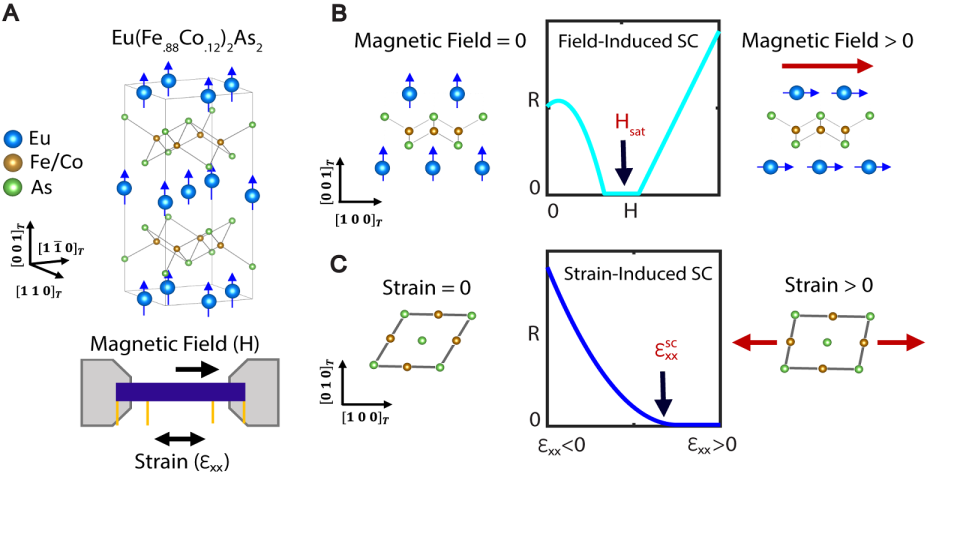U.S. Govt and researchers seemingly discover new type of superconductivity in an exotic, crystal-like material — controllable variation breaks temperature records

A group of physicists from the University of Washington and the U. S. Department of Energy (DOE) have seemingly discovered a new, controllable variation of superconductivity in an exotic, crystal-like material. Its superconductivity can be modulated according to the strain applied to it, to the point of turning it off at will. Simultaneously, they've apparently broken the record on how "hot" a field-effect superconductor can be before it loses its ability to conduct electricity, absent any resistance.
What's a Superconductor?

Superwhat? Here's what you need to know about superconductors, how they work, and why they're key to PCs.
The time hasn't yet come for the room-temperature, ambient-pressure superconductor, but a temperature record is a temperature record, even if it's (still) around the 10 K barrier (-263.5 ºC).
The research paper (published in Science Advances) describes a synthetic, crystal-like sandwich of both ferromagnetic (Europium) and superconductive materials (Iron Arsenide), which showcase emergent superconductivity when placed in the proximity of a strong enough magnetic field. Doped EuFe2As2, as the material is called due to the addition of Cobalt molecules to the synthesis process, takes advantage of Europium's (Eu) strong ferromagnetism, alternated with superconducting/nematic FeAs (Iron Arsenide) layers in a sandwich-like configuration.
The result is what's known as a field-tunable superconductor -- one whose superconductivity features can be enabled through the application of external magnetic fields. In the case of doped EuFe2As2 (and by deploying specialized equipment alongside a combination of X-ray techniques), the research team showed how a properly aligned external magnetic field counterbalances the magnetic fields emanating from the ferromagnetic Europium layers. This allows them to be reoriented - and once the originally chaotic magnetic fields are parallel to the superconducting ones, a zero-resistance state of matter emerges.
But doped EuFe2As2 has another secret: its superconducting capabilities can be turned off even in a strong enough magnetic field. All that's needed is to strain the material with a cryogenic strain cell - to apply pressure from a single side (uniaxially) with what's akin to an industrial, scientific-measurements-certified piston -- to modulate how much resistance electrons find while traversing it. Under certain strain levels, the superconductivity of the synthetic material can be boosted enough so that an external magnetic field isn't required to enable a superconductive state. But after a point, not even pressure gets the engines going. Two different mechanisms for superconductivity can only go so far, but they also open up several opportunities in customizing superconductivity -- an additional lever to pull.

The researchers noted difficulties in their synthesis process despite the overwhelming quality of documentation (they did it themselves, after all). The research team wasn't able to discern what prevented viable samples of Cobalt-doped EuFe2As2 from resulting from the synthesis process; instead, they reported "substantial sample to sample variability," where variability refers to whether the samples presented field-induced superconductivity or not. The researchers further noted the difficulties likely arose in the Cobalt doping stage of the recipe, a confirmation of how difficult it is to control quantum processes (such as chemical reactions) at the level of precision some of these synthetic materials that are bearers of superconductivity require.
These are subtle, subatomic element changes and interactions -- that's truly all that's required for morphing a material from semiconductivity to superconductivity. But that simpleness hides a complex interaction of elements, particles and subatomic particles, spins, magnetic fields, and many more parameters in a way that's just right - or in the case of the researcher's samples, between 4 Kelvin and 10 Kelvin of rightness.
This level of resolution and control into the moment superconductivity gets "turned off" (which is the same as the moment it gets "turned on" but different, in a very quantum way) should provide invaluable insights into the quantum physics of superconducting. At the very least, the newly discovered superconductor can be a testbed for a better understanding of superconductivity itself -- being able to see the molecular transition from normal matter to its superconductive phase at higher and higher resolutions should increase our ability to control the effect and extract further usefulness from it.
And if anything, the book in condensed matter physics still has several blank pages to pour discoveries onto, this novel superconducting mechanism included. Not that it's hard to imagine places where perfectly-conducting circuits that never heat up would be great: Argonne National Labs states that this discovery could "find uses in superconducting circuits for next-generation industrial electronics." I'll take a Ryzen 15 Super Cooper, please.

